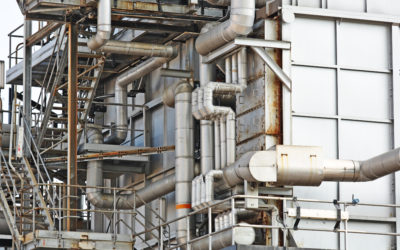Understanding Stress Corrosion in Heat Exchangers
Stress corrosion is a significant concern in industries that rely heavily on metal structures exposed to corrosive environments, such as oil and gas, energy, and manufacturing. It occurs when mechanical stresses, whether residual or externally applied, combine with a corrosive medium, leading to material degradation. Two key forms of stress corrosion are stress corrosion cracking (SCC) and corrosion fatigue.
Stress Corrosion Cracking (SCC)
SCC occurs when static tensile stress causes a metal to crack in a corrosive environment. The combined factors create localized damage that eventually leads to structural failure. Materials that could withstand the same stresses in non-corrosive environments become vulnerable. Heat exchangers are particularly susceptible to SCC, especially in areas with residual stresses, like welded joints or U-bends.
How It Happens: Residual stresses from welding, cold working, or corrosion products can act as stress concentrators. Corrosion products can expand, creating stress in confined spaces, which weakens the material and leads to cracks over time.
Corrosion Fatigue
Corrosion fatigue results from fluctuating loads that rapidly degrade metal strength when coupled with a corrosive environment. Unlike SCC, corrosion fatigue arises from dynamic stresses that occur below the yield point, often initiating at stress concentration points.
Example: In heat exchangers, corrosion fatigue is often seen when materials undergo repetitive loading cycles, which become significantly damaging in the presence of corrosive agents like acids, chlorides, or water vapor.
Preventing Stress Corrosion with HeatX
Stress corrosion can lead to catastrophic failures, especially in critical systems like pipelines and heat exchangers. One of the most effective ways to mitigate stress corrosion is through the use of advanced surface treatments. HeatX offers a superior solution by providing a sustainable, water-based surface treatment that forms a protective barrier, reducing the likelihood of corrosion.
Why HeatX is Effective:
- Corrosion Resistance: HeatX forms a robust surface layer that shields metals from corrosive environments, making it an excellent choice for systems prone to SCC and corrosion fatigue.
- Environmental Benefits: Being a sustainable surface treatment, HeatX helps companies meet environmental standards while offering long-lasting protection.
- Prolonged Service Life: By reducing the effects of stress corrosion, HeatX minimizes the risk of equipment failure, thereby extending the lifespan of critical infrastructure like pipelines and heat exchangers.
As industries continue to push the boundaries of material performance, the need for advanced protection against stress corrosion is paramount. By implementing HeatX as part of a corrosion prevention strategy, companies can significantly enhance the durability of their assets, ensuring safety, longevity, and environmental compliance. Reach out to our experts for more information on HeatX.



